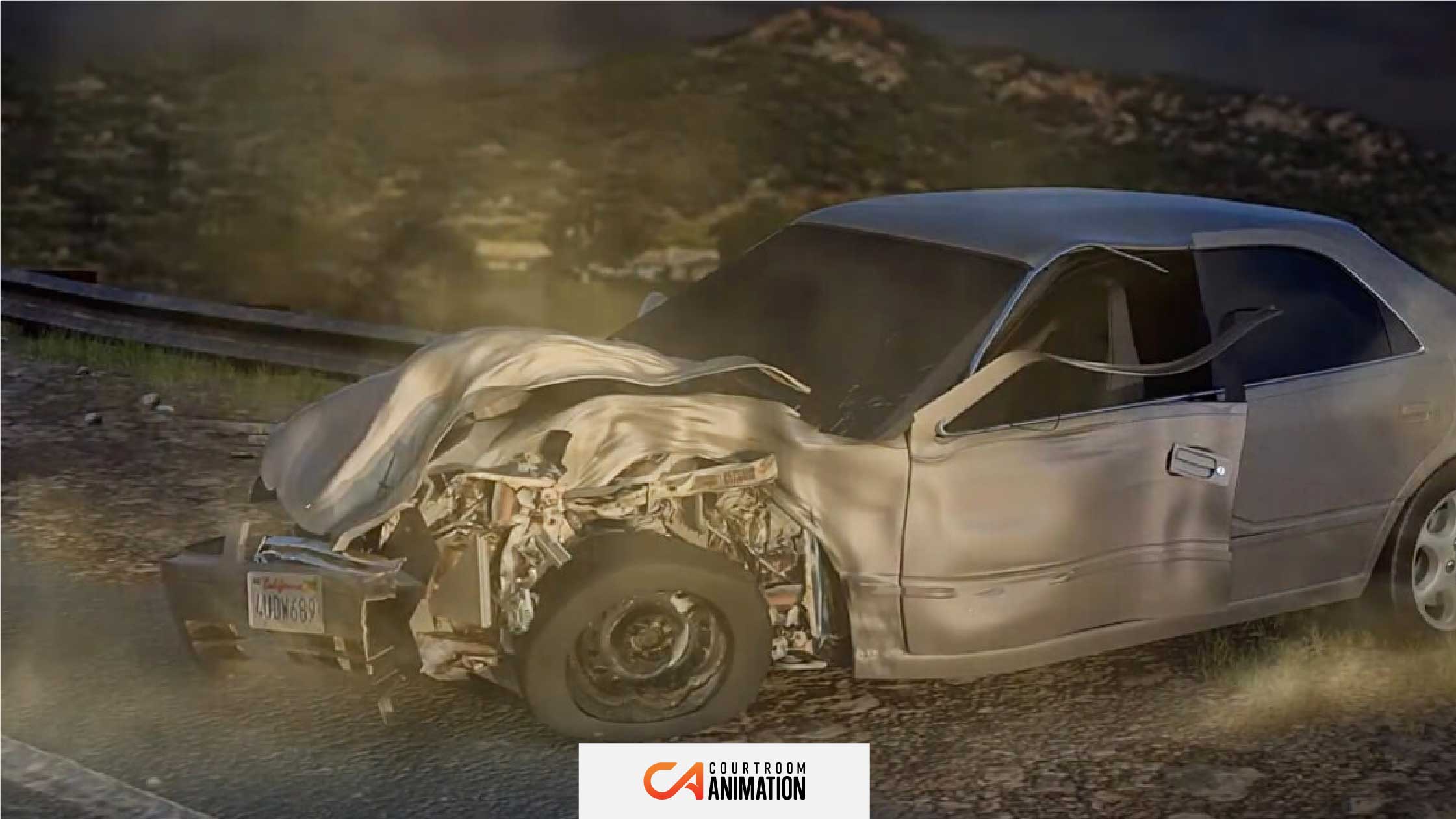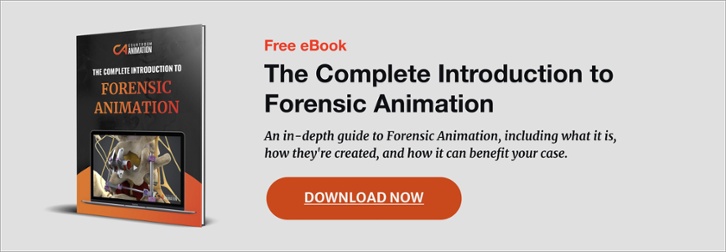
Animations of vehicle accidents are a convincing tool to help a jury, or other parties, understand how a car crash accident occurred. A car crash animation can be created for different viewpoints, whether it be a “birds-eye” view, the driver or witnesses’ perspective, or any other position that helps depict the accident. Without this animation, a jury has to rely on other forms of evidence that cannot always give the needed context to understand how and what happened.
When everything is seen separately, it’s difficult to put a story together, especially when so much information needs to be remembered.
Animation brings all of those puzzle pieces together into one comprehensive graphic, so a jury and other parties can see for themselves how the scene unfolded—such as environmental factors, speed, visibility, space, awareness, behavior, and so forth. When a jury is able to see how everything comes together in a persuasive way, they tend to remember the event with clarity.
Let’s go over some of the specific ways car crash animation can win your client’s court case.
1. Behavior
Car crash animation is a great way to showcase the way people or vehicles were behaving before, during, and after a collision takes place. Was the driver inebriated when the accident occurred? Were they on their routine walk or drive home? Did someone fall into the road? Was a car moving or at a stop? Did a biker ride through a stop sign?
Take this animation, for example, depicting a child cyclist who unfortunately rode into the path of a moving bus:
As you can see, we were able to depict from multiple viewpoints how the child rode his bicycle into the path of the bus. You’ll notice how the boy is riding on the sidewalk when somebody he knows waves to him down the street, which distracts him enough to ride through the intersection without stopping or looking. The animation also shows how little time the driver had to react. Similar animations can be created to support defense attorney’s motor vehicle collision cases. For example, if the defense party wanted to visually show how the driver was negligent.
Without forensic animation, it’s extremely difficult for relevant audiences or a jury to understand behaviors based on eyewitness testimony and verbal presentations, whether they are plaintiff or defense cases.
2. Time
Using car crash animation, you can distort temporal relationships, such as slowing down a scene or speeding up a sequence of events. This can easily showcase how little time someone had to react to a situation, or allow audiences to observe otherwise difficult-to-see events.
Notice in this video how two cars on a highway are driving at full speed, and when the accident occurs, the animation slows down so you can better visualize the impact of the collision.
If the animation would have depicted the collision at full speed, it might have looked like the car clipped the truck. Slowing down the impact enables you to see that the car did in fact lift the truck in the air. Furthermore, the surgery that took place after the accident is sped up so you can understand the severity of the injury. This type of surgery in real-time would have taken hours to perform. The animation speeds up the long process and simplifies it for a jury so they can easily comprehend the full implications of the accident.
3. Alternative Scenarios
Being able to show alternative scenarios of a vehicle collision is of particular importance in cases that involve different versions of the crash. In these situations, alternative scenarios can depict the more probable way that an event took place by taking in factual variables to reconstruct a scene.
At Courtroom Animation, we often use “ghosted animation” to depict these alternative scenarios. For instance, we can show how an event unfolded, such as a car running through an intersection. And then we can show a “ghost” car, depicted as such, which represents the alternative scenario, showing what would have happened if the car had stopped before the intersection.
Alternative scenarios show audiences what would have happened, or what could have been avoided, if people had made different decisions.
Perspective
Showcasing the perspectives of the drivers involved in a collision as well as eyewitnesses is paramount in the successful use of 3D forensic animation. Not only that, but animation also gives your audience the ability to see a collision from overhead, other perspectives, and other revealing angles.
Take this collision animation, for example:
This collision took place on a blind curve on a windy road. Our team of animators were able to create highly realistic and accurate depictions of the collision from different perspectives. First, you get to see the witness’s perspective behind the driver that was hit.
Then you see the driver’s perspective, which gives you an idea of how little time they had to react. The last two views give the audience a plan view and railing view to help remove any remaining ambiguity regarding how the collision took place.
5. Realism
One of the powerful aspects of car crash animation is how realistically events are portrayed. Especially compared to computer-generated simulations, it leaves a better and longer-lasting impression on jurors and other viewers. Mostly, that’s because audiences expect this type of technology.
After all, that’s what they’re used to seeing in modern-day movies, social media, video games, and other media forms. It’s much more powerful than computer-generated simulations due to how outdated that technology looks to an audience. Alternatively, car crash animation takes the simulation data that engineers produce and covers it with realistic graphics (such as skin) to make it more palatable for audiences.
The Bottom Line of Car Crash Animation
Car crash animation, simply put, explains the nuances surrounding the facts of a collision in a way that testimony, photos, and medical reports cannot. Photos can show you what happened after the fact, but animation can show you things that happened during, like how a body moved inside the vehicle during the point of impact.
Compared to seeing all the aspects of a collision separately, animation ties together injuries, damages, and other factors into one comprehensive graphic. This way, a jury and others will better remember what happened so they can make more informed decisions.
These reasons and more are why 3D car crash animations are a useful tool that can gain a favorable result for your client.

Topics: